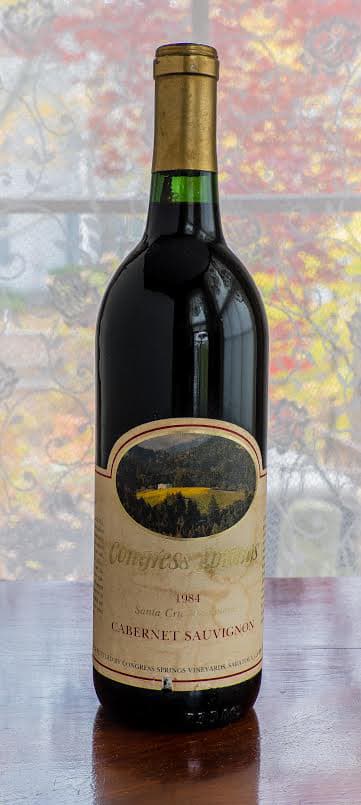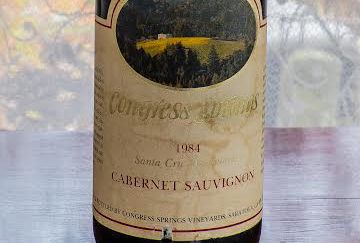Before I opened this 30+-year-old Cabernet Sauvignon, I tried several other odd bottles, only to discover that they were alive but not out of the ordinary. Two of them were Pinot Noirs, a 1988 from the West Coast (Sonoma) and a 1996 from the East Coast (Finger Lakes).
Oh, it was sad trying to convince myself to enjoy those wines. Sometimes we do that — tell ourselves a wine is worth our time and effort when it is not. (Sometimes we do that with people as well, which can get us into even more trouble.)
Those wines were not…interesting. That’s the thing. They were drinkable but not profitably sniffable or tasteable or relatable.
I don’t want to write about wines that are not good. Or good enough. There’s a place for that, but not here, where wines are not reviewed consumer-wise but are celebrated (old, quirky wines in particular).
So I turned to a wine made from a grape more likely to have survived its time in a bottle. It happened to be a wine I’d never had. And a wine I’m likely never to have again, because it is no longer made. Indeed, the winery itself is gone.* Truly, it was an odd bottle.
The Congress Springs 1984 Cabernet Sauvignon is from the Santa Cruz Mountains. Its label says, “Congress Springs is a small premium winery dedicated to quality. It is located 50 miles south of San Francisco and 30 miles inland from the Pacific Ocean…”
What seems to be the most quoted opinion (it’s all over the internet) about the Santa Cruz Mountains is this from Antonio Galloni in Robert Parker’s Wine Advocate (2012): “There is no doubt in my mind the Santa Cruz Mountains is the greatest and most overlooked terroir in the United States…producing riveting, emotional, world-class wines.”
I’m not sure what an “emotional” wine is (one that gets upset when you say you don’t like it?), but I have no argument, based upon my tasting of this old Congress Springs Cabernet (and other wines from this area, in particular those from Ridge Vineyards), that Galloni is right: the wines can be spectacular, and people who ignore these mountain wines for those from the mountains of Napa have no idea what they’re missing.
What they will inevitably miss is, in the case of this wine, to quote again from its label, “a less heavy and tannic wine than is grown elsewhere. This is a fine and supple claret-style wine, matured in French oak barrels, which can improve from five to ten years from the vintage date.”

tasting of this old Congress Springs Cabernet (and other wines from this area, in particular those from Ridge Vineyards), that Galloni is right: the wines can be spectacular, and people who ignore these mountain wines for those from the mountains of Napa have no idea what they’re missing.
What they will inevitably miss is, in the case of this wine, to quote again from its label, “a less heavy and tannic wine than is grown elsewhere. This is a fine and supple claret-style wine, matured in French oak barrels, which can improve from five to ten years from the vintage date.”
It’s now almost thirty-two years from the vintage date. The wine was bottled in a rather ugly smallish green bottle with absolutely no punt.
It’s now almost thirty-two years from the vintage date. The wine was bottled in a rather ugly smallish green bottle with absolutely no punt.
(It was not yet fashionable to use heavier glass and more shapely dimensions to try to get consumers to believe that these might indicate greater quality within. Tinted glass is commonly used for red wines to reduce the oxidizing effects of light.)
The cork was dry and broke in two within the bottle; a two-pronged opener didn’t then succeed, but the long worm of my beloved BonJour Le Bouchon corkscrew (no longer available, but the replacement worm is) removed the remainder of the cork.
Poured into a large Riedel glass, the wine was blood-red at its core, and only when tilted against a sheet of white paper did it reveal a satisfying fading-to-gold at its edge. Its color no more revealed its advanced age than does a vibrant voice the age of a speaker. It made me want to hear the little-known Rolling Stones song “Blood Red Wine” (“I got blood red wine…”)
A full pour into the glass revealed a bit of sediment. This was not unexpected, but I had chosen not to decant the wine because I hadn’t known if the wine might be on the fragile side and thus deteriorate quickly. I wanted to taste the wine over several days, and decanting might have seriously shortened the life of the wine – oxygen is both friend and foe.
On first taste, the wine was lean but not at all thin (“claret-style”), not bursting with fruit but full of fruit, which was a good thing. It was drunk with a meal of semi-boneless roast leg of lamb served with spiralized zucchini noodles in a kale pesto sauce. Perfect.
The next day it was drunk at lunch with some leftover confit of duck legs. The wine gave the impression that it was even fresher than it had been on its first day of final life, which must be because I was drinking it earlier in the day. (No wine gets “fresher” over time.) It was as suitable to the duck confit as almost any wine from the south of France.
On the third day, it said a bit of a halting goodbye to me and to some leftover roast pork, with which it matched up perfectly because it was losing some of its power and had lightened up to become more (in color and intensity, not, of course, in taste) like the pinot noir I would normally prefer with pork.
It’s gone now. All that’s left of it, for me, is this telling of the tale of its long life in the bottle and short life in the glass. So it goes, and should go, with all great wine. ![]()
* Congress Springs has been revived as a name in Lodi. What was Congress Springs Vineyards in Saratoga, CA, is now Savannah Channel Vineyards, which makes no wines from Cabernet Sauvignon. And by the way, Eric Asimov has written recently in The New York Times about Santa Cruz Cabernet.
First published June 2016
